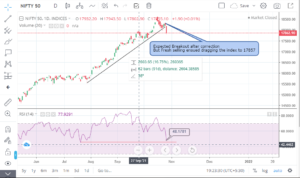Technical Indicators – An indicator is a feature that points to something by providing an output in the form of a signal by taking an input. In short technical indicators are pointers. Therefore, most people use technical indicators to enter a trade. In stock markets, people use technical indicators to determine the direction of price movement. Identify market trends and trend reversal of an underlying asset. A technical indicator is dependent on three inputs to predict the price movements they are as follows.
- Time
- Volume
- Price Action i.e – Rate of change of price with respect to time and volume (Momentum)
Within the technical analysis of an asset, we have two different kinds of Indicators. They are as follows.
- Leading Indicators – These indicators are used for forecasting or preempting a move in advance.
- Lagging Indicators – These indicators lag the price action and are more used by investors.
To read an explanation of the types of indicators, visit IG.com. One can refer to this source for a better understanding of the topic.
Top Technical Indicators for a Trader
There are two categories of traders based on the duration for which they are willing to hold an asset.
Note “The most important thing for a trader is liquidity. If this is missing then, traders are going to gasp for air.”
- Intraday Traders are often known as day traders
- Positional Traders can hold a security for a day, week or even months
For Intraday Traders
Firstly, Intraday traders have very little time for holding a trade. Therefore they must act quickly because their decision can either make or break their capital. Secondly, the period of their analysis is 1 min, 5 min, 10 min, 15 min, and 30 min.
It is so because they have only 6 hours to trade – to learn more about market timing, visit the link. Suppose the analysis is for a longer time frame then, that’s not intraday. Because, in intraday trades, the positions have to be mandatorily squared off within the trading hours of the same day.
- Pivot Points
- RSI – Relative Strength Index
- Moving Average Both Long term and Short term
- Trend Lines – Charting
- Bollinger Bands
For Positional Traders
Positional traders are people who can hold the stock because they have enough capital for holding an asset. They use margin or leverage for trading. Because even without margin, they can take deliveries of their assets. Positional traders are also people who have enough free time to monitor their trades.
There is only one thing that a positional trader should keep in mind. The amount of leverage should not exceed the total amount of cash they have. For example, a share is trading at 100 Rs, and a positional trader buys 10000 units of that share, in the margin that is by taking leverage then, the trader should have 10,00,000 cash in account otherwise, the trader would lose the money if the trade flips in the unexpected direction.
For a positional trader, the time frame or duration on the candle chart is – 1 hour, 1 – day, 1 week, and 1 – month
- RSI – 1-day candle chart
- Moving average – DEMA crossover – 10, 20, 50, 100, 200 days
- Pivot points on a 1-day candle chart
- P/E, P/B, and Debt Analysis
- News of the company
- Trend Reversal on daily, weekly, and monthly candle charts spotted
A reference Book for Traders & Investors
The Technical Analysis for dummies is one of the best books written on Candles, Candlesticks, and Technical Indicators. You can buy this book from our top Top10 best books for the trading and investment section.




